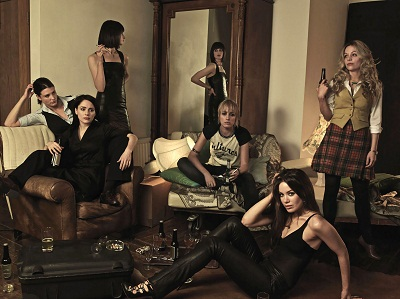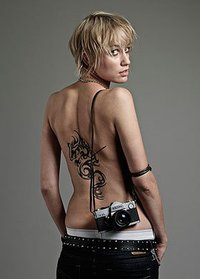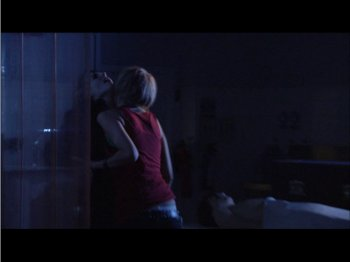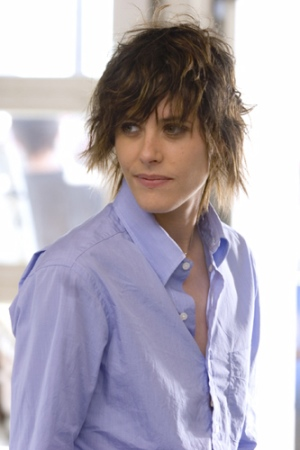More than just ‘Lip Service‘?- Stereotypes in lesbian focused drama
Faye Davies / Birmingham City University

Lip Service was the first BBC screened ‘lesbian drama’ set in the contemporary era. Aired in the United Kingdom on BBC3 during October and November of 2010 the Glasgow based lesbian drama wasn’t heavily previewed or advertised, although in lesbian circles it found huge popularity and has just finished shooting a second series of six episodes. The series was aired on BBC3 which is aimed at the 16-34 age group and continues as part of the UK’s public service system and ethos – it has universal access in terms of UK viewers and no advertising. BBC3 output is mainly UK and Europe based (90%). Lip Service pulled in a relatively high audience (for placement on a digital channel) of 580,000 viewers for its opening night (total UK audience share of 4.4%). The Guardian called Lip Service ‘hugely significant’1. This column considers the popular Lip Service in context alongside another recent lesbian drama: The L Word with a particular focus on introducing ideas for discussion around the representation of butchness and bisexuality.
When a high number of viewers engage with lesbian, gay or bisexual representation, even in the contemporary era – it takes on credence, a credibility and believability. There are a wide number of people who don’t encounter gay lives, lesbian or gay sexuality and its resultant dramas, problems, or various considerations. Once this is represented, it takes on an importance; it constructs a reality for a large proportion of society. For lesbian viewers it also ‘speaks of the self’ – especially in terms of the formation of identity for young lesbians. Lesbian focused drama is still relatively rare and so the burden of representation is heavy.

This is particularly pertinent as once there is some plurality of representation it appears that stereotypes relating to a particular culture begin to emerge and develop and these are what can be considered noteworthy in terms of identity politics. What is interesting with regard to these two dramas is that there is a clear pattern of stereotyping emerging. Distinctions will be drawn in what follows with my brief study of The L Word which can be found in greater detail in Televising Queer Women2, although in this column I will only offer a brief mapping of the stereotype formation around butchness and bisexuality alone.
Initially what seems to be set up in both of these shows is the discursive dichotomy of ‘butch’ and ‘femme’. Whilst these labels are hugely problematic in theoretical terms – they seem inextricably linked to key narratives in these lesbian focused dramas. It is arguable that the distinctions between the two identities are connected to sexual practices and relationships which are arguably forming the dominant discourses of lesbianism for the mainstream. On the one hand we see the lead butch in Lip Service: ‘Frankie’:
[youtube]http://www.youtube.com/watch?v=sF4bK9_e2rE[/youtube]
In Lip Service, Frankie can be considered as emotionally and morally void in a number of senses. Discursively she is constructed as driven by sexual practice and her own sex drive; arguably to beyond the point of her own control. We see her having anonymous sex with a model she photographs (after just learning her Aunt/mother figure has died) having anonymous sex in a mortuary at a funeral parlour just after viewing her Aunt’s body (next to a body on a mortuary slab).

Frankie also has sex with her male best friend who is engaged and eventually her female ex-partner who has just moved in with a new lesbian partner.
One aspect of Frankie’s character connects clearly with the butchness of Shane in The L Word. This is in both aesthetic and act:

Shane is a character whose actions, ‘equate with promiscuity and emotional detachment’3. Even in these two (arguably) mainstream shows there is a clear stereotype emerging in terms of ‘butch’ lesbian sexuality. This construction is emotionally void in sexual act and often immoral in relationships. This is hugely problematic for the ‘butch’ identity as it mimics the feminist considerations of masculinity as problematic in a lesbian feminist sense4.
But Frankie also communicates some familiar discourses around bisexuality. In The L Word bisexuality is constructed as ideologically problematic as an ‘interim’ and low in the order of discourse which prioritises the solid categories of lesbian or straight5. TLW’s bisexual characters such as Jenny Schechter (seemingly bisexual in Season 1 and 2) are constructed as unbalanced at best. We also saw ‘quirky’ Alice Pieszecki, who again had a ‘dwindling’ bisexuality throughout the show’s run. Between them, these two characters relate the insecure, the unfaithful, the cheater, the unsettled; essentially there is a characterisation of bisexual characters as indecisive and unable to manage their lives in a way that is always successful and balanced. These are all aspects of Frankie’s character which are clearly communicated by the narrative in Lip Service.
The most pertinent point is that these constructions are making the invisible visible6 – this is the stereotype that is appearing to develop in lesbian focused drama involving the 25-35 age group. These dramas are constructing what it means to be butch or bisexual to both a gay and straight audience whose prior understanding of gay culture might be vast or nil; and it is the latter which may be more problematic for identity politics and assumptions about bisexual and gay lifestyles.
What is problematic about such emerging representations is that they are pushed to the fore in the audience mind, and whilst avoiding any ‘hypodermic’ assumptions or accusations that these representations are either ‘good’ or ‘bad’, it’s important to remember that western screens are not awash with lesbian focused dramas. The stereotyping outlined above can only encourage far more audience research to understand the development, impact and formation of stereotypes and their ideologies in the minds of both gay and straight audiences.
Image Credits:
1. The Cast of Lip Service
2. Frankie
3. Frankie’s Anonymous Sex
4. Shane
Please feel free to comment.
- Cahalane, Claudia (2010). Lip Service is groundbreaking – whatever its star says, The Guardian (London: Guardian Media Group). http://www.guardian.co.uk/commentisfree/2010/oct/13/lip-service-groundbreaking-lesbian-drama. Accessed 15 October 2010. [↩]
- Davies, F (2008). ‘Paradigmatically Oppositional Representations: Gender and Sexual identity in The L Word’ IN Beirne, R (2008). Televising Queer Women, Palgrave MacMillan: New York. [↩]
- Davies, F (2008). ‘Paradigmatically Oppositional Representations: Gender and Sexual identity in The L Word’ IN Beirne, R (2008). Televising Queer Women, Palgrave MacMillan: New York. 186. [↩]
- Jeffreys, S (2003). Unpacking Queer Politics, Polity: Malden MA, USA. [↩]
- Davies, F (2008). ‘Paradigmatically Oppositional Representations: Gender and Sexual identity in The L Word’ IN Beirne, R (2008). Televising Queer Women, Palgrave MacMillan: New York. [↩]
- Dyer, R (2003). The Matter of Images: Essays on Representation 2nd ED, Routledge: London. [↩]
A very interesting article, thank you.
However, regarding this:
‘TLW’s bisexual characters such as Jenny Schechter (seemingly bisexual in Season 1 and 2) are constructed as unbalanced at best. We also saw ‘quirky’ Alice Pieszecki, who again had a ‘dwindling’ bisexuality throughout the show’s run. Between them, these two characters relate the insecure, the unfaithful, the cheater, the unsettled; essentially there is a characterisation of bisexual characters as indecisive and unable to manage their lives in a way that is always successful and balanced.’
I’m not sure it’s entirely fair to attribute this to their bisexuality, and I don’t think The L Word does so. Alice’s bisexuality seems to be a part of her quirky ‘try anything’ personality. Apart from that Dana-stalking phase, she doesn’t seem to be presented as unstable (and again, that kind of instability didn’t seem to be presented as stemming from a bisexual nature, or the other way around – Alice isn’t unstable, I don’t think, she’s just open-minded and adventurous). And while, yes, Jenny’s bisexuality was – for a while – part of her indecisive, infuriating nature, I don’t think being insecure, unfaithful and unsettled are really connected to bisexuality by The L Word overall; while Laurel Holloman’s Tina does go back to dating men for a while, Jennifer Beals’ Bette is the programme’s most notorious serial cheater (remember the campfire scene?) – and she is only ever involved with women.
I do agree that Frankie’s bisexuality seems to be linked to instablilty – an irresponsible, hurtful promiscuity possibly stemming from a childhood trauma – but I’m not sure it’s quite precise to connect this with bisexuality in The L Word in the way you do here. While it is definitely fair to regard The L Word‘s dealings with bisexuality as problematic, I’m not convinced that those problems stem from bisexuals being characterised in quite the way you suggest.
I am, however, very interested to see where Lip Service will take Frankie’s behaviour in the second season (and, on a personal level, can’t believe anyone would ever choose Frankie over Sam. That’s what’s really shocking here, no…?)
Thanks for your insights Fiona – some interesting thoughts.
This piece, being short in nature, was to highlight some of the stereotypes which seem to be emerging around lesbian focused drama. Clearly, it hasn’t been possible to outline the wider discussion of the orders of discourse presented in such programming which seems to privilege lesbians or straights as more stable. But I’d appreciate your feedback on the more detailed studies published – I’ve provided links to much more detailed analysis of this for TLW across the seasons.
I don’t think it’s always inextricably the case that bisexuals are presented as unstable – but certainly think there is a sense in TLW that bisexuality is presented as a state which is rather insecure and through the entire series narrative, was one which rather diminished in terms of representations (this seemed to be the key discourse). It certainly seems a problematic representation when lesbian stereotypes are really only just starting to form in lesbian focused dramas – mainly as there have been so few of them. Bisexuality doesn’t ‘speak’ positively to me in these series – and I think this is something we should pay attention to as theorists; especially as they are so rare in mainstream TV.
….and by the way – I totally agree few people would choose Frankie over Sam! Maybe it was that ‘danger’ thing!
LS bothered me. I was bothered that I really wanted it to be good but was ultimately disappointed by the whole thing because of the obviousness of it all. All characters were one-dimensional not just the lesbians. When there will be a lesbian drama apart from adaptations from Sarah Waters’ novels that are any good?
I think Lip Service is better than the L word.
I think it has more depth and it’s not only about their relationships, but also about other things.
I think the L word is too much focused on the relationships between the woman, and over all it’s not very realistic. I mean, it’s about a whole bunch of lesbians who are all each other’s friends and who have different relationships with each other. Lip Service is just about 3 lesbians who have relationships with other women, and not constantly with each other. besides I think Lip service has better actors.
Faye, thanks for this piece, some interesting observations here. I suppose the big problem here is that NEITHER Shane NOR Frankie are particularly butch – they are a straight man’s fantasy of a butch woman, or perhaps more generously, a media-friendly version of butchness. Which is to say, not butch at all. The L Word, whilst genuinely innovative and interesting, continued to have problems with (mis)representation (the offensively written trans storyline of Season 3, anyone?) – but at least it included characters who were complex, well-written, well-acted and who we came to care about. Lip Service on the other hand is just dire – derivative, wooden, one-dimensional. I don’t think queer women should feel compelled to celebrate it because its the first UK lesbian drama – although part of me is appalled by that, another part is not convinced by the whole queer representation issue in any case. As a young queer I simply ‘lesbianised’ moments from right across culture – much more satisfying fantasy life than relying on/waiting for the Beeb to represent my sexuality!
Thanks Grr! I think there are a variety of problems with representation of lesbian character in ‘lesbian drama’. Although lesbians have been represented across a variety of genres and narratives, we are only just starting to see ‘lesbian’ drama which focus distinctly on lesbian life and culture and some of the stereotypes we see forming are potentially problematic. I guess TV production will never please everyone, especially not in the commercial environment but the social stereotypes and cultural assumptions surrounding these groups is particular worthy of research at such a time.
Your article is really interesting in terms of how you identify the specific possibilities of (mis)representation that are enacted in the characterizations of Shane of TLW and Frankie of LS, and specifically in the representation of bisexuality within TLW. I would like to add to your observation of the problematic depiction of bisexuality by addressing other components and characterizations of TLW, in order to address the show’s overall inability to consistently and effectively engage with its narrative framework about the queer community’s diversity and fluidity. As Eve Kosofsky Sedgwick states in her article “The L Word: Novelty in Normalcy”, the show provides a “generous contextualization of its characters’ intertwined lives, where no single character, relationship, or issue need be the lesbian one.” She aptly describes the work of the show as generative of a ‘lesbian ecology’ that boasts of queer representational diversity. However, while lesbianism overall within the show’s narrative diegesis takes a backseat in order to allow other aspects of life to operate dramatically-at-center (to include, for example, Helena’s problematic use of her wealth to access Tina’s intimacy, and Bette’s work-related dramas at the university), TLW diverts from this narrative tone by enacting bisexuality as a dramatic element in and of itself.
In terms of Jenny’s bisexuality, I think what became most problematic in the representation of such was not so much the confusion she felt about her sexual orientation upon moving to Los Angeles with her husband (which led to subsequent infidelity), but moreso in the way she negotiated her simultaneous relationships with a man and woman in Season 1. What became most problematic in this dynamic was moreso the discomfort felt by Jenny’s lesbian and straight male suitors that was directly inflicted by Jenny’s sexual orientation and preference for plurality. This characterization adds to the problematic texture of the depiction of bisexuality within the show’s narrative threads and characters, as Jenny’s sexual fluidity seems to generate problems not just within her own behavior (i.e. her infidelity), but within the collective space of the show. So while the show surely delivers the diversity of the queer community in its overall representation of said community, it simultaneously enacts specific dramatic uses of bisexuality that work to construct this specific sexual orientation as more or less stereotypically problematic and fractious both for the bisexual character as well as the people with whom he/she interacts.
Bisexuality rears its head again throughout the series as a dramatic instigator when Tina gets intimately involved with a man during her hiatus from Bette. As a viewer, I was rooting for the success of Tina and Bette’s relationship, especially in light of the show’s propping of a ‘lesbian ecology’ and its distinction from a heterosexual and heteronormative community. During the depiction of Tina’s relationship with said man, the viewer seems to be aligned with Bette’s isolation and sadness, thus perhaps deeming Tina’s bisexuality as one of the problematic components keeping Tina and Bette apart. This becomes even more problematic, as now Tina’s bisexuality is paired directly with Bette’s infidelity within this overall dramatization of the Bette-and-Tina narrative thread. Bisexuality becomes tethered to unstable intimacy, working as a liminal and tenuous factor of destruction more than as a stable and invisible entity as with the show’s depiction of lesbianism and heterosexuality (as you mentioned, Faye, in relation to Jenny and Alice).
Overall, this fixed stereotypical representation of bisexuality within a show whose larger framework seems dedicated to exploring the complexity of the queer spectrum, as well as the fluidity of human sexuality at large, works to taint the show’s excellent modes of characterization and narrative complexity that otherwise deals respectfully with its depiction of a marginalized community. Like you, I am interested in the audience reception of these representations, with a specific interest in seeing if queer and straight audiences ingest these specific characters’ actions and characterizations as synonymous with their correlative sexual orientation, or if they glean from the show’s overall investment in depicting the queer community’s diversity and complexity the opportunity to divorce the assumption of synonymy between sexual orientation and human behavior.